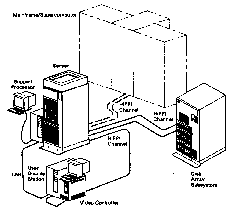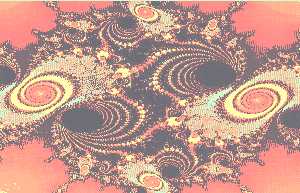
Book Review:
Chaos and Fractals
A Computer Graphical Journey
edited by Clifford A. Pickover
reviewed by John de Rivaz
Overview
This is a big book - big in content, heavy in weight, high in quality of manufacture, and high in price. It appears to be aimed those who have not read any of Dr Pickover's books before and who want to use the power of a modern desktop computer to emulate and possibly advance on ideas in chaos theory that appeared in the late 1980s and the 1990s. If that is your purpose, then buying this one book may well be a very good move as opposed to buying many back copies of Computers and Graphics and three or more smaller books. Dr Pickover's selection that he has reproduced in Chaos and Fractals could well be all you need.
What You can Do With It
It is a rough rule of thumb that the power of the mainframe appears on the desktop in 10 years, so if you see pictures like these

There are some shorter projects too, with software listings. As an exercise, I scanned in the listing for J. C. Sprott's Automatic Generation of Strange Attractors (1993). I had it scanned in and working in less than a quarter of an hour. A few minor changes were needed as BASIC is not, of course, an exact language and it varies from version to version. It would in fact have converted into a very nice little "screensaver" had I spent more time - but of course in 1993 "screensavers" were not so popular. It is a tribute to the quality of paper and reproduction that the scanning was so fast and successful. There are many other listings in the book and I am sure that they could be got working with equal ease.
There are also lots of articles without listings and these would make projects for those wishing to learn graphics programming that would be shorter than the ambitions quaternion flythough mentioned before.
Computer Art
The articles range from the deadly serious "frontiers of mathematics" type to deliberate attempts to use chaos theory to produce objects of artistic merit. Computer art has not yet hit the artistic word in any big way. One can still go around an art gallery and see the results of some photographic artist having spent five years using wet chemical methods to produce something that a PC could have done in five minutes. Art PhDs may still admire this outdated enterprise and stand in awe when they see the result in the art gallery. But the future must lie in the sum total of modern computer methods and some form of artistic talent, coupled of course with good sales technique and social standing in the art world. I would advise any up and coming student of modern art to buy this book (or persuade his college library to buy it) and study the sections on computer art - that is where the future of the next generation of artists lie. Desktop computer systems have moved beyond being toys and can produce real work. Not being computer literate, even for an art student, is as big a disadvantage as not being able to read and write was to an earlier generation. In fact it is a bigger barrier - a painter could get by without being able to read and write, but not if he couldn't wield the tools of his trade, however talented his ideas. Computers will be one of the main tools of art in the coming years.

To produce the computer art results in a paper dated 1994, Dr Pickover used the contraption shown to the right:
Today, with the advances in desktop graphics, the pattern reproduced below could be generated on any modern machine using ideas expressed in the article Automatic Parallel generation of Aeolian Fractals on the IBM Power Visualization System.

The Future
I expect that we shall see more books like this. Hopefully in the future they will also contain CDs where applications for the IBM PC have been made available for people to load in and run straight away. Using the Internet and getting one volunteer for each article it should be possible to use "human parallel processing" not to make it too arduous a task for any one individual. Each volunteer could be rewarded by a copy of the completed book and CD.
Ideally a company like Microsoft could also donate a license to a version of Visual Basic so that the book could contain a Visual Basic development application and source codes that readers could modify. It need not be the latest Visual Basic - an older version is capable of a lot of graphics work, and who knows, the project could help produce a new generation of Visual Basic programmers.
It has been suggested that the style of Dr Pickover's books was doomed to a slow death once programming languages were no longer bundled with new computers. Without buying a development package such as Visual Basic, no one would write Basic as a casual activity. Bundling Visual Basic (or something similar) with a disk at the back of these books may be one solution. Bulk printings of CDs cost about 10 pence each, so the costs are in the development only.
In Conclusion
If you fit into any of the categories of people who would benefit from this book, then you will not be disappointed by it.
You may buy it by post for NLG 320 from
Elsevier Science
Molenwerf 1
1014 AG Amsterdam
Holland
or you may buy it by post for $184 from
Elsevier Science
PO Box 945,
Madison Square Station,
New York,
NY 10160-757
U. S. A.
Or you may buy it off the web by credit card by cutting and pasting this into your browser (or click here if you are reading the html version)
http://www.amazon.com/exec/obidos/ISBN=0444500022/longevitybooksA/
The above link may provide additional information and reviews.